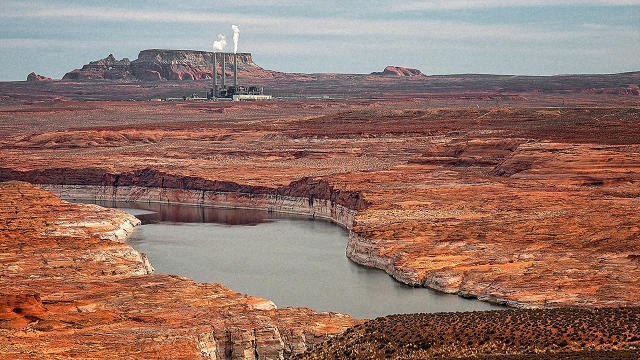ArcStar Energy
Three years ago, the EPA struck a deal with the owners of the largest coal plant in the Western U.S. to close the plant by 2044. Now—because of economics, not regulation—the owners plan to shut the plant down by 2019 instead.
The Navajo Generating Station, 12 miles from the Grand Canyon near Page, Arizona, is the seventh largest individual source of climate pollution in the country, pumping out more than 14 million metric tons of carbon dioxide emissions a year. It's also a major source of air pollution for people living nearby; by some estimates, shutting it down will also save more than $127 million a year in health costs.

Both the plant and the nearby coal mine also use a significant amount of water that would otherwise be used as drinking water for the Navajo Nation. "It's clean water that they're using," says Percy Deal from Dine Care, a local Navajo environmental group. "I really believe that it's time to put an end to that. That 31,000 acre-feet of water is Navajo water, and for almost 50 years now, Navajos have not been able to use it."
While Navajos have experienced the negative effects of the plant and mine, the power has been sent elsewhere; 18,000 homes on the reservation still don't have electricity.
Like other coal plants, the Navajo Generating Station has been struggling to compete with cheap natural gas. The plant's customers have been paying more than they would otherwise. The Central Arizona Project, one of the main purchasers of power, reported in a recent presentation that they could have saved $38.5 million in 2016 by purchasing power at standard market rates instead of the coal plant.
Coal plants also face competition from renewables, at a time when demand for new electricity in the U.S. is growing slowly.
"As new gas-fired and renewable resources are being added every month, this means that more supply-side resources are competing for the same or almost the same demand," David Schissel, director of resource planning analysis at the Institute for Energy Economics and Financial Analysis, tells Co.Exist. "This is not good for coal."
Despite Trump's promises to "bring back coal," it's unlikely that policy can make much of a difference. "The market forces working against coal are inexorable," Schissel says. "Maybe by throwing lots of money at coal, eliminating environmental regulations, and trying to slow down the development of renewables, the new administration can slow the pace at which coal plants will be retired in the near future, but it can't stop the process entirely or reverse it."
The new administration also plans to increase production of natural gas, which would further hurt coal. Wind and solar power are also so cheap now that it makes economic sense to continue to build new renewable power.
The Navajo plant has also lost major customers recently. The electric utility in Los Angeles sold off its stake in the plant in part because of California's cap and trade program, which limits the amount of climate pollution utilities and companies can release. A Nevada electric company also pulled out of the plant in order to reduce emissions.
It's the latest of many coal plants to plan to close. Less than three weeks ago, Dayton Power and Light announced that it would close two large coal plants in Ohio in 2018, and develop new solar and wind projects. Duke Energy has closed 12 coal plants over the past five years, with another scheduled to close in 2020. Tennessee Valley Authority has closed three coal plants since 2011.
The trend will continue. "The market forces working against coal are not going away," says Schissel. "What the owners of Navajo have been saying about the economics of their plant is reflective of what's happening to the entire industry."
At the Navajo plant, which is a major employer in the area and also provides revenue for the tribe, some members of the Navajo nation are lobbying Trump to intervene and keep the plant open. But better jobs could be on the horizon; the site happens to be one of the best locations for solar development in the country, and solar power is now one of the fastest-growing sources of new American jobs.
"The Navajo Nation and the Hopi tribe are concerned about the revenue that they're collecting from these industries, and rightfully so," says Deal. "But they knew that the end was coming and there should have been preparation to replace that revenue. There is the opportunity to do that within the next couple of years, which is to really sit down and talk about a cleaner industry—for example, solar and wind . . . The transmission lines are already there."

No comments:
Post a Comment